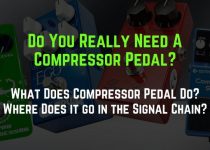Do I Need a Reverb Pedal? (The Definitive Guide 2022)
Reverb is one of the most popular effects in the music world and featured somewhere in almost every player’s rigs. But, do you really need a reverb pedal?
The reverb pedal offers pleasing and natural-sounding layers of ambiance and emotions to the sound and creates sonic characteristics of rooms or hallways to create a sense of “live performing” sound. It comes with lots of control knobs that impart a nice versatility in your sound by allowing you to change the acoustic response of the space.
In acoustics and psychoacoustics, reverberation is defined as the persistence of sound in the environment even after the sound has been produced by its source (your Instrument).
In simple words:
Reverb is nothing but an audio effect that aims to recreate the natural-sounding acoustic reverberation in your guitar’s sound. Mostly, a reverbed signal is mixed back with the dry (original) signal in order to achieve a greater sense of space.
What Does Reverb Pedal Do?
You can achieve a reverb effect by using spring tanks, huge steel plates, or with clever use of a microphone and playback. That’s where reverb pedals come into play. It allows you to recreate the acoustics of real-sounding spaces through digital algorithms with a single tap.
Every room, building, or hallway has its own acoustic characteristics that create small echoes of sound that are combined together to create a natural reverberation. We often miss these sonic signatures when playing through an amplifier without using any reverb effect.
With a reverb pedal, you can give pleasing and natural-sounding layers of ambiance and emotions to your guitar to create a sense of “live” sound even when you’re playing in your bedroom.
The depth control knob on the pedal allows you to change the size of the space whereas by controlling the tone knob, you can change the overall acoustic response of your music.
But:
Many amplifiers come with a built-in reverb effect! Is there any difference between pedals and amplifier reverb?
Amp Reverb vs Reverb Pedals: Which is Better?
Generally, the amplifier reverb is considered as a more organic and natural-sounding effect especially from tube amps but provides you less flexibility and control over the tone.
On the other hand, the pedals create reverb effects through digital algorithms and are considered as a more versatile option to play and experiment with.
Unfortunately, most of the budget amplifiers come with a limited number of onboard EQ controls. That’s why I always considered effect pedals as an excellent base to customize your guitar tone.
Even a super budget-friendly reverb pedal allows you to control various sonic parameters to achieve the perfect and unique sounding tone. Basically, If you’re a beginner to effects and want full control over your tone, a reverb pedal will be a more suitable option for you.
Where Does a Reverb Pedal Go in a Chain?
As a general rule, the reverb pedal works best at the last of the signal chain because its main job is to introduce the sonic illusion in the music by replicating the acoustics of the room, hall, or any other sonic space.
Most guitar players prefer to place it after the delay pedal so that your delay effect still remains clear. but you can of course experiment with different combinations. Ex. you can achieve classical gritty-sounding tones by placing a reverb pedal before an overdrive effect.
How You Can Choose The Best Reverb Pedal?
Choosing the right reverb pedal that is suitable for your needs while fitting in your budget range can be a challenging task. That’s why I created this buyer’s guide and list out my favorite reverb pedal models below for you.
These are a few important things you should look for:
- Budget: There is nothing fancy here. In almost all cases, the more money you pour, more versatile and high-quality gear you’ll get. That’s why its important to decide how much money you want to spend on a reverb pedal?
- Versatility: You need to decide whether you’re looking for a one main reverb sound or want to adjust and switch between different reverb tones? But you need to understand, usually, more versatile the pedal, more control knobs are there. are you ready to deal with them?
- Simplicity: There are some pedals that comes with only one or two knobs, which is great if you prefer ease in playability and simplicity of the gear and just want to add a little depth and richness to your sound.
- Availability of Presets: Presets allows you to save your different tone settings, so that you can dial them back without manually adjusting all the control knobs. I wouldn’t say it’s a must have but definitely a very useful feature.
- Size of the Pedal: Does pedal size matters to you? how much space do you have on your pedalboard? You need to consider all these points to pick the perfect pedal according to your needs.
There are countless reverb pedals out there in the market makes it very easy to get lost in the features and big brand names. that’s why I am listing my two hand-picked models that can save you a lot of headaches.
If you occasionally use a reverb effect, I suggest you to go with a more compact and budget-friendly pedal like Flamma FS02 Stereo Reverb Pedal that offers an amazing value and covers all the essential features on a very low budget.
But: If you’re into a genre where reverb is an absolute core of your music, you should invest in a sexy beast like Electro Harmonix Cathedral Reverb that provides you a wide range of reverb effects and allows you to dial in the exact tone you’re looking for.
Why Are Reverb Pedals so Expensive?
The reverb pedals are expensive because they offer a number of features and different functions which required a development cost to create hardware that is compact enough while meeting an expected level of versatility and quality performance.
Can you Use a Guitar Reverb Pedal for Vocals?
You can use a guitar reverb pedal for vocals to make a dry (natural) vocal sound more refined and better sounding to the audience. Although it’s not the most prominent voice modification method but it does help to create a thicker vocal sound.
Should I get Delay Pedal or Reverb Pedal First?
As a general rule, you should get a reverb pedal first, as it imparts nice texture to your sound while offering you nice tone versatility.
The Delay pedal helps you to make your solo sound huge, make the bland part more interesting and add a nice depth to the rhythmic section, whereas the reverb pedal creates a sense of live sound by recreating sonic characteristics of real-sounding spaces.
Final Thoughts: Do I Need a Reverb Pedal
The way you add a reverb effect in your music completely depends on your personal taste but there is no doubt it is one of the most important and wildly used effect pedals in the music world.
I hope you get a clear idea of whether or not you want a reverb pedal for your music. If you have any kind of doubt, feel free to put it down in the comment section. Also, don’t forget to share this helpful guide with your guitar friends.
Happy Music!
You May Also Like to Read:
- Do you Need a Compressor Pedal?
- Do you Need a Fuzz Pedal?
- Do you Need a Tuner Pedal?


